Disclosure: We may earn commissions if you purchase products after clicking on a link from our site.
Do you want to learn how to catch blackfin tuna? Are you looking for a new fishing adventure? Do you want to catch monster fish? Blackfin tuna is one of the most exciting sporting fishes that anglers like to target; they fight very hard, take explosive bites, and are delicious. They are also challenging to catch of their wide range and migratory habits.
Blackfin tuna can be found in the western Atlantic Ocean from North Caroline, the Gulf of Mexico to Brazil. In this article, we will share information about fishing methods, baits and lures, fishing tackle, and tips and tricks to make your dream of catching this monster a reality.
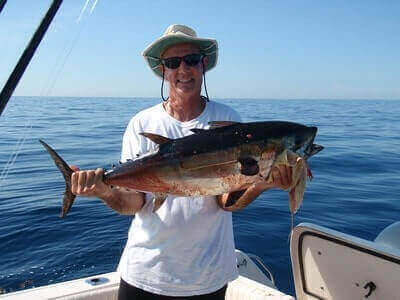
Table of Contents
- 1 How To Catch Blackfin Tuna
- 2 Blackfin Tuna Tackle
- 3 Best Baits For Blackfin Tuna
- 4 Best Lures For Blackfin Tuna
- 5 How To Catch Blackfin Tuna From Pier
- 6 How To Catch Blackfin Tuna In the Gulf of Mexico
- 7 How To Catch Blackfin Tuna In Florida
- 8 How To Catch Blackfin Tuna In North Carolina
- 9 Blackfin Tuna Fishing Tips
- 10 The Bottom Line
How To Catch Blackfin Tuna
Blackfin tuna can be caught year-round and are known to take an explosive bite. They are hard fighters and for their size and weight, you must be ready for the battle that ensues. These are just some of the reasons anglers like to catch this sporting monster of a fish. There are many fishing methods and techniques that can be used when you are learning how to catch blackfin tuna.
1. Trolling
Trolling is a popular and effective method for targeting blackfin tuna in offshore waters. Anglers deploy a spread of lures, typically using diving plugs, feathers, or skirted baits, behind a slow-moving boat. The boat moves at varying speeds, usually between 5 to 10 knots, to simulate the movement of a school of baitfish, enticing blackfin tuna to strike.
This method allows anglers to cover large areas of water and locate active fish. When trolling for blackfin tuna, it’s essential to use heavy-duty tackle and wire leaders to withstand the powerful runs and sharp teeth of these fish.
Additionally, anglers should vary the trolling depths and lure colors to find what the fish are responding to best. For more information on how to catch blackfin tuna using trolling techniques, anglers can consult resources provided by fisheries management organizations such as NOAA Fisheries: Link to NOAA Blackfin Tuna Fishing Guide.
2. Vertical Jigging
Vertical jigging is a highly effective method for targeting blackfin tuna, particularly when they are holding near underwater structure or thermoclines at varying depths. Anglers use heavy metal jigs, typically weighing between 2 to 6 ounces, and drop them vertically through the water column while drifting or anchored over productive areas.
Once the jig reaches the desired depth, anglers impart erratic jigging motions to mimic the movements of injured baitfish, enticing blackfin tuna to strike. Vertical jigging requires precise rod control and timing to maximize success, as blackfin tuna are known for their powerful and fast-paced fights.
For more information on how to catch blackfin tuna using vertical jigging techniques, anglers can consult resources provided by state fisheries management agencies such as the Louisiana Department of Wildlife and Fisheries: Link to LDWF Blackfin Tuna Fishing Regulations.
3. Chunking
Chunking is a specialized technique for targeting blackfin tuna, particularly in areas where they congregate around offshore structures such as oil rigs, seamounts, or underwater wrecks. Anglers use chunks of baitfish, such as bonito or mackerel, to create a chum slick in the water, attracting blackfin tuna to the area.
To employ this method, anglers anchor near the structure and deploy a steady stream of bait chunks into the water, creating a scent trail that draws in hungry fish. Once blackfin tuna are present, anglers can present baits on heavy tackle using either live or dead baitfish rigged on circle hooks.
Chunking requires patience and persistence but can yield rewarding results for anglers targeting blackfin tuna. For more information on how to catch blackfin tuna using chunking techniques, anglers can consult resources provided by state fish and wildlife agencies such as the Florida Fish and Wildlife Conservation Commission: Link to FWC Blackfin Tuna Fishing Regulations.

4. Kite Fishing
Kite fishing is an innovative and effective method for targeting blackfin tuna, especially in offshore waters where these fish are often found feeding near the surface. Anglers deploy specialized fishing kites attached to fishing lines, which allows them to suspend baits, such as live or dead baitfish, at the desired depth and distance from the boat.
The kite acts as a wind-powered float, keeping the bait positioned in the water while the boat remains stationary or drifts slowly. This technique enables anglers to present baits naturally and enticingly, mimicking the movements of struggling or injured prey, which can attract the attention of blackfin tuna.
Kite fishing requires careful attention to wind conditions and kite rigging to ensure proper bait presentation. Anglers must also be prepared to quickly reel in any strikes as blackfin tuna are known for their aggressive takes and strong runs. For more information on how to catch blackfin tuna using kite fishing techniques, anglers can consult resources provided by fishing charter companies, angling forums, or fishing guidebooks specialized in offshore fishing techniques.
5. Drift Fishing
Drift fishing is a versatile and effective method for targeting blackfin tuna in offshore waters. Anglers use this technique to cover a large area while presenting baits or lures to actively feeding fish. To drift fish for blackfin tuna, anglers first locate productive areas such as underwater structures, current breaks, or temperature breaks where blackfin tuna are known to congregate.
Once in position, anglers allow the boat to drift naturally with the current while deploying baits or lures at varying depths using heavy tackle. Popular baits for drift fishing include live or dead baitfish such as bonito, mackerel, or squid, while lures such as diving plugs, feathers, or skirted baits can also be effective. Anglers must constantly monitor their drift speed and adjust their presentation accordingly to ensure their baits or lures remain in the strike zone.
Additionally, anglers should be prepared to quickly set the hook and fight the powerful runs of blackfin tuna when they strike. Drift fishing allows anglers to cover a wide range of depths and areas, increasing their chances of encountering feeding blackfin tuna. For more information on how to catch blackfin tuna using drift fishing techniques, anglers can consult resources provided by fishing charter companies, offshore angling forums, or fishing guidebooks specializing in offshore tactics.
Blackfin Tuna Tackle
You can use either spinning or conventional tackle. Braided or monofilament lines can be used when fishing for blackfin tuna. A medium-heavy rod spooled with 350 yds of 30lb test. The tackle can be about 6-12 ft of 50lb fluorocarbon leader with a 4/0 live bait hook.
Blackfin tuna can refuse to bite if they spot the leader with their good eyesight. The remedy is to use fluorocarbon leaders. Smaller hooks are also the way to go when fishing for blackfin tuna. A 4/0 – 6/0 size circle hook will work well when learning how to catch blackfin tuna.
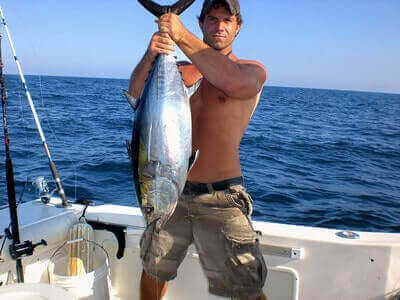
Best Baits For Blackfin Tuna
- Squid
Squid is a highly effective bait for targeting blackfin tuna in offshore waters. These cephalopods offer a natural and enticing presentation that can attract the attention of hungry tuna. Anglers often use whole or strip squid as bait, rigging them on circle hooks or jigs to mimic the appearance of squid swimming in the water.
Squid can be fished both near the surface and at depth, making them versatile options for targeting blackfin tuna at various depths in the water column. When using squid as bait for blackfin tuna, anglers should deploy them either on a drifting or trolling setup, depending on the fishing conditions and the preferred depth of the fish. Squid’s natural scent and texture make it irresistible to blackfin tuna, often resulting in aggressive strikes.
Additionally, squid is readily available at most bait shops and can be easily stored and transported for offshore fishing trips. For more information on using squid as bait for catching blackfin tuna, anglers can consult resources provided by state fish and wildlife agencies, fishing guidebooks, or offshore fishing forums specializing in tuna fishing tactics.
2. Pilchards
Pilchards, also known as scaled sardines or white bait, are highly sought-after baitfish that are particularly effective for targeting blackfin tuna in offshore waters. These small, silvery fish offer a natural and enticing presentation that can trigger aggressive strikes from hungry tuna. Pilchards can be fished either live or dead, with both presentations proving effective for enticing blackfin tuna.
Anglers typically rig pilchards on circle hooks or jigs to mimic the natural swimming motion of the baitfish. When using pilchards as bait for blackfin tuna, anglers often deploy them either on a drifting or trolling setup, depending on the fishing conditions and the preferred depth of the fish. Pilchards are known for their oily flesh and strong scent, which can help attract blackfin tuna from a distance.
Additionally, pilchards are relatively easy to catch or purchase from bait shops, making them a convenient and practical option for offshore fishing trips targeting blackfin tuna. For more information on using pilchards as bait for catching blackfin tuna, anglers can consult resources provided by state fish and wildlife agencies, fishing guidebooks, or offshore fishing forums specializing in tuna fishing tactics.
3. Pinfish
Pinfish, a small and abundant baitfish found in coastal and offshore waters, can be an effective bait for catching blackfin tuna. While not as commonly used as other baits such as squid or pilchards, pinfish can still entice strikes from blackfin tuna, especially in areas where they are prevalent. Anglers often rig pinfish on circle hooks or jigs to mimic their natural swimming behavior in the water.
When using pinfish as bait for blackfin tuna, anglers typically deploy them on a drifting or trolling setup, depending on the fishing conditions and the preferred depth of the fish. Pinfish offer a natural and enticing presentation, particularly when presented alive, as they emit vibrations and movements that can attract predatory fish like blackfin tuna.
However, it’s essential to ensure that pinfish are legal to use as bait in the fishing location, as regulations may vary. For more information on using pinfish as bait for catching blackfin tuna, anglers can consult local fishing regulations, state fish and wildlife agencies, or offshore fishing forums specializing in tuna fishing tactics.

4. Cigar Minnows
Cigar minnows, a popular baitfish found in offshore waters, are highly effective for targeting blackfin tuna. These slender fish offer a natural and enticing presentation that can attract the attention of hungry tuna. Cigar minnows are often rigged on circle hooks or jigs to mimic their natural swimming behavior in the water.
When using cigar minnows as bait for blackfin tuna, anglers typically deploy them on a drifting or trolling setup, depending on the fishing conditions and the preferred depth of the fish. Cigar minnows emit subtle vibrations and movements that can attract predatory fish like blackfin tuna, making them a preferred bait option for many anglers targeting tuna species.
Additionally, cigar minnows are readily available at most bait shops and can be easily stored and transported for offshore fishing trips. It’s essential to ensure that cigar minnows are legal to use as bait in the fishing location, as regulations may vary. For more information on using cigar minnows as bait for catching blackfin tuna, anglers can consult local fishing regulations, state fish and wildlife agencies, or offshore fishing forums specializing in tuna fishing tactics.
5. Herring
Herring, a baitfish commonly found in offshore waters, can be an effective bait for targeting blackfin tuna. These oily and flavorful fish offer a natural and enticing presentation that can attract the attention of hungry tuna. Anglers often rig herring on circle hooks or jigs to mimic their natural swimming behavior in the water.
When using herring as bait for blackfin tuna, anglers typically deploy them on a drifting or trolling setup, depending on the fishing conditions and the preferred depth of the fish. Herring emit strong scents and oils that can help attract blackfin tuna from a distance, making them a preferred bait option for many anglers targeting tuna species.
Additionally, herring can be purchased frozen or fresh from bait shops and can be easily stored and transported for offshore fishing trips. It’s essential to ensure that herring are legal to use as bait in the fishing location, as regulations may vary. For more information on using herring as bait for catching blackfin tuna, anglers can consult local fishing regulations, state fish and wildlife agencies, or offshore fishing forums specializing in tuna fishing tactics.
6. Live Bait
Live bait is often considered one of the most effective options for targeting blackfin tuna. Whether it’s pilchards, pinfish, herring, or other small baitfish, presenting live bait can yield excellent results when targeting these elusive fish. Live bait offers a natural and enticing presentation, with the movements and vibrations emitted by the live baitfish mimicking those of injured or struggling prey.
Anglers typically rig live bait on circle hooks or jigs to maintain their natural swimming behavior in the water. When using live bait for blackfin tuna, anglers can deploy them on a drifting or trolling setup, depending on the fishing conditions and the preferred depth of the fish. Live bait can be particularly effective when fishing near underwater structures, current breaks, or temperature gradients where blackfin tuna are known to congregate.
Additionally, live bait can attract blackfin tuna from a distance, increasing the chances of a successful catch. However, it’s essential to ensure that live bait is legal to use in the fishing location and that proper bait-handling techniques are followed to keep the baitfish healthy and lively. For more information on using live bait for catching blackfin tuna, anglers can consult local fishing regulations, state fish and wildlife agencies, or offshore fishing forums specializing in tuna fishing tactics.
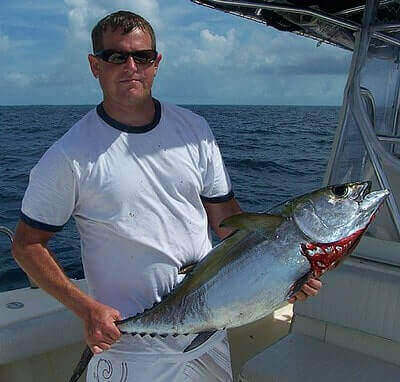
Best Lures For Blackfin Tuna
- Cedar Plugs
Cedar plugs are a popular and effective lure for targeting blackfin tuna in offshore waters. These wooden lures are designed to mimic the swimming action of small baitfish, making them enticing to predatory fish like blackfin tuna. Cedar plugs are typically rigged with a leader and trolled behind a boat at varying speeds, depending on the fishing conditions and the preferred depth of the fish.
Anglers can deploy cedar plugs on a spread of lines, covering a wide area to increase the chances of encountering feeding tuna. When using cedar plugs as a lure for catching blackfin tuna, anglers should pay attention to the lure’s action and adjust trolling speed or depth to optimize its performance. Cedar plugs are known for their durability and effectiveness, making them a staple in many offshore trolling spreads.
Anglers can also experiment with different colors and sizes of cedar plugs to determine which variations are most attractive to blackfin tuna in their area. For more tips on how to catch blackfin tuna using cedar plugs, anglers can consult fishing guidebooks, and online tutorials, or seek advice from experienced anglers familiar with offshore trolling techniques.
2. Small Feathers
Small feathers, commonly referred to as feather lures or feather jigs, are a popular and versatile option for targeting blackfin tuna in offshore waters. These lures consist of colorful feathers or synthetic materials tied onto a jighead, creating a lifelike baitfish profile that can entice predatory fish. Feather lures are typically trolled behind a boat at varying speeds, depending on the fishing conditions and the preferred depth of the fish.
Anglers can deploy feather lures on a spread of lines, covering a wide area to increase the chances of encountering feeding tuna. When using feather lures as a lure for catching blackfin tuna, anglers should pay attention to the lure’s action and adjust trolling speed or depth to optimize its performance. Feather lures are known for their simplicity, affordability, and effectiveness, making them a popular choice among anglers targeting blackfin tuna.
Additionally, anglers can experiment with different colors, sizes, and configurations of feather lures to determine which variations are most attractive to blackfin tuna in their area. For more tips on how to catch blackfin tuna using feather lures, anglers can consult fishing guidebooks, and online tutorials, or seek advice from experienced anglers familiar with offshore trolling techniques.
3. Ballyhoo Rigs
Ballyhoo rigs are a tried-and-true method for targeting blackfin tuna in offshore waters. These rigs consist of a pre-rigged ballyhoo baitfish attached to a hook, often with a colorful skirt or teaser to enhance its appeal. Ballyhoo rigs can be trolled behind a boat at varying speeds, allowing anglers to cover a wide area and locate feeding tuna.
The natural swimming action and appearance of ballyhoo closely mimic that of live baitfish, making them highly attractive to predatory fish like blackfin tuna. When using ballyhoo rigs to target blackfin tuna, anglers should pay attention to trolling speed, depth, and the presentation of the rig to optimize success.
Additionally, anglers may choose to enhance the effectiveness of ballyhoo rigs by incorporating attractants such as scent or flash to further entice tuna. Ballyhoo rigs are known for their simplicity and effectiveness, making them a popular choice among anglers pursuing blackfin tuna. For more tips on how to catch blackfin tuna using ballyhoo rigs, anglers can consult fishing guidebooks, and online tutorials, or seek advice from experienced anglers familiar with offshore trolling techniques.
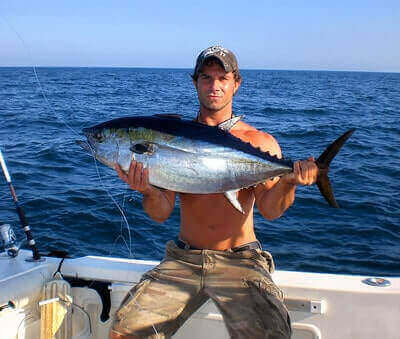
4. Vertical Jigs
Vertical rigs, also known as butterfly jigs or vertical jigs, are a highly effective method for targeting blackfin tuna in offshore waters. These rigs consist of heavy, metal jigs designed to sink rapidly through the water column, mimicking the movement of fleeing baitfish.
Anglers deploy vertical rigs by dropping them directly beneath the boat and jigging them up and down through the water column. This technique is particularly effective for targeting blackfin tuna holding at various depths, from the surface down to deep structures or thermoclines.
When using vertical rigs to catch blackfin tuna, anglers should pay attention to the action of the jig and vary their jigging motion to entice strikes. Additionally, anglers may choose to add a strip of bait or a colorful teaser to the jig to enhance its appeal.
Vertical rigs offer anglers a versatile and exciting way to target blackfin tuna, and they can be especially effective when fish are holding deep or are not actively feeding on the surface. For more tips on how to catch blackfin tuna using vertical rigs, anglers can consult fishing guidebooks, online tutorials, or seek advice from experienced anglers familiar with offshore jigging techniques.
5. Spoons
Spoons are a versatile and effective lure for targeting blackfin tuna in offshore waters. These metal lures, typically shaped like a concave spoon, are designed to flutter and flash in the water, mimicking the movements of injured baitfish. Anglers deploy spoons by trolling them behind a boat at varying speeds, covering a wide area to locate feeding tuna. Spoons can also be cast and retrieved or jigged vertically, providing anglers with multiple presentation options.
When using spoons to catch blackfin tuna, anglers should pay attention to trolling speed, depth, and the action of the spoon to optimize success. Additionally, anglers may choose to enhance the effectiveness of spoons by adding a strip of bait or a colorful teaser to attract tuna. Spoons come in a variety of sizes, colors, and finishes, allowing anglers to match the local baitfish and conditions.
Their versatility, durability, and effectiveness make spoons a popular choice among anglers targeting blackfin tuna. For more tips on how to catch blackfin tuna using spoons, anglers can consult fishing guidebooks, and online tutorials, or seek advice from experienced anglers familiar with offshore trolling techniques.
How To Catch Blackfin Tuna From Pier
Many anglers go fishing for blackfin tuna from the pier. Most of the time, they will use plugs to cast into the pier and when a fish is hooked, the line is retrieved. It is a repetitive process of casting and retrieving until you get a bite.
There are other fishing methods like chumming and vertical jigging that you can use when fishing from a pier, but casting and retrieving is one of the most widely used methods when fishing from a pier.
How To Catch Blackfin Tuna In the Gulf of Mexico
When fishing for blackfin tuna in the Gulf of Mexico, anglers use a variety of fishing methods such as trolling, live baiting, chunking, and vertical jigging. Trolling is one of the popular fishing methods for blackfin tuna fishing. Anglers often use cedar plugs and skirts when trolling for blackfin tuna.
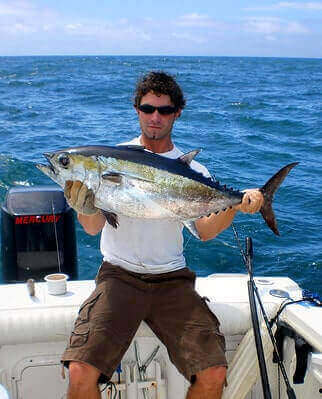
How To Catch Blackfin Tuna In Florida
Blackfin tuna fishing in Florida is implemented by trolling or live chumming. Anglers use cedar plugs and skirts when trolling for blackfin tuna. Other lures are also used when trolling; however, these have proven to be very effective.
Live chumming is another effective fishing technique used when fishing for blackfin tuna. Pilchards, squid, pinfish, cedar minnows, and herring are some of the baits that can be used when targeting blackfin tuna.
How To Catch Blackfin Tuna In North Carolina
Fishing for blackfin tuna in North Carolina is similar to how anglers target it all along the Atlantic coast and the Gulf of Mexico. Trolling, chumming, drift fishing, and vertical jigging, are the best fishing methods used.
Blackfin Tuna Fishing Tips
- Blackfin tuna are low-light feeders. They are found in deep waters preying on squid.
2. Blackfin tuna can be found in wrecks, current rips, underwater mounds, or humps.
3. Blackfin tuna migrate vertically through the water column during the day to feed.
4. When you are looking for schools of blackfin tuna, if there are large flocks of birds circling above the water, there is a good chance that they are following schools of blackfin tuna trying to intercept flying fish and other forage that the blackfin tuna are feeding on.
5. Blackfin tuna has very good eyesight. Therefore, it is a smart idea to scale down your leaders and hooks to improve the chances of being unnoticed by blackfin tuna.
6. A 4/0 – 6/0 size circle hook is a good size when learning how to catch blackfin tuna.
7. Using live chum, you can attract and raise blackfin tunas closer to the water surface and lure them closer to your boat.

8. Trolling, vertical jigging, live baiting, chunking, and kite fishing are some of the fishing methods used to catch blackfin tuna.
9. Live baits, such as herring, goggle-eye, sardine, or pilchards, are the best bait when fishing for blackfin tuna.
10. Blackfin tuna can grow up to 40 pounds or more and their average weight is about 25 pounds.
11. The best time for blackfin tuna fishing is spring and fall.
12. Blackfin tuna can be caught all year round.
13. Spend some time planning your blackfin tuna fishing trip by reviewing tide charts and weather forecasts.

14. Fresh live bait is the best bait when learning how to catch blackfin tuna.
15. The best time of the day to go fishing for blackfin tuna is early morning and sunset.
16. When there is a full moon, blackfin tuna will bite during the middle of the day when the moon is on the opposite side of the earth.
17. Blackfin tuna are a leader and hook-shy. A fluorocarbon leader is the best option.
The Bottom Line
Blackfin tuna is an exciting sport fish that anglers target year-round. It is hard fighting, makes explosive bites delicious, and makes great runs. In this article, we discussed how to catch blackfin tuna, the baits and lures anglers use, as well as shared fishing tips to help you catch this monster of a fish. You can also read how to catch yellowfin tuna, how to catch bigeye tuna, how to catch blackfin tuna, and how to catch bonito.